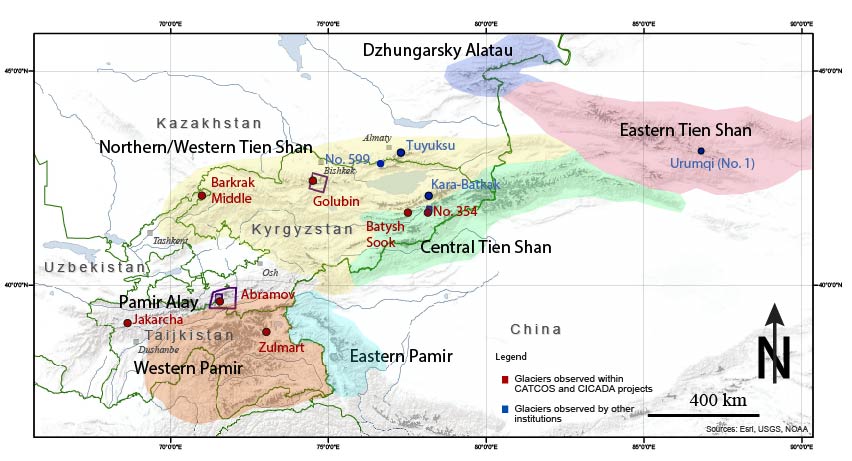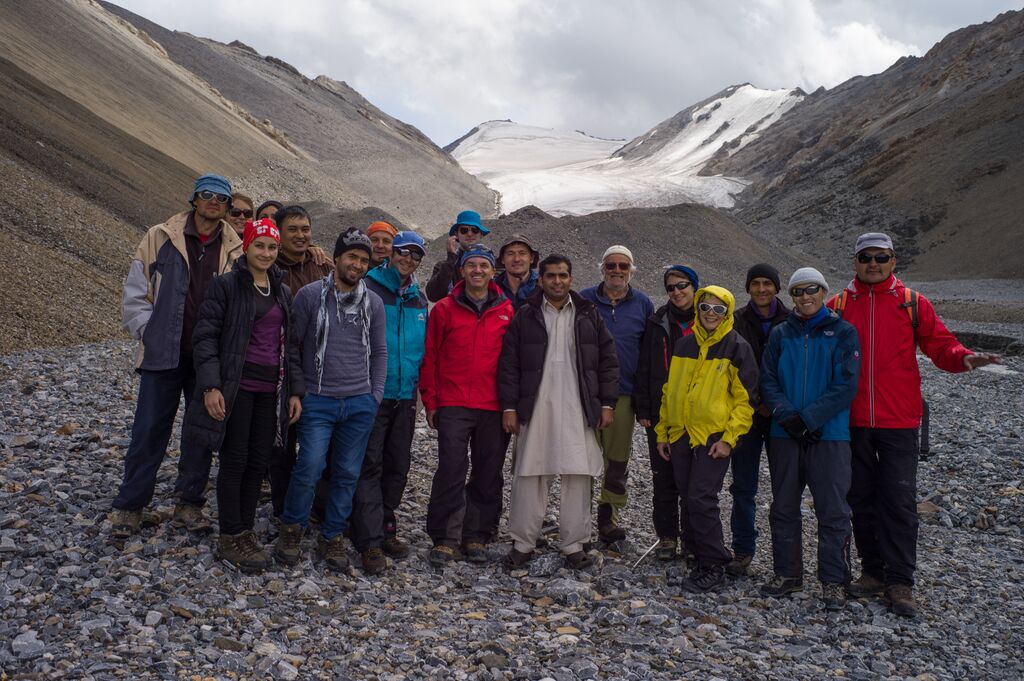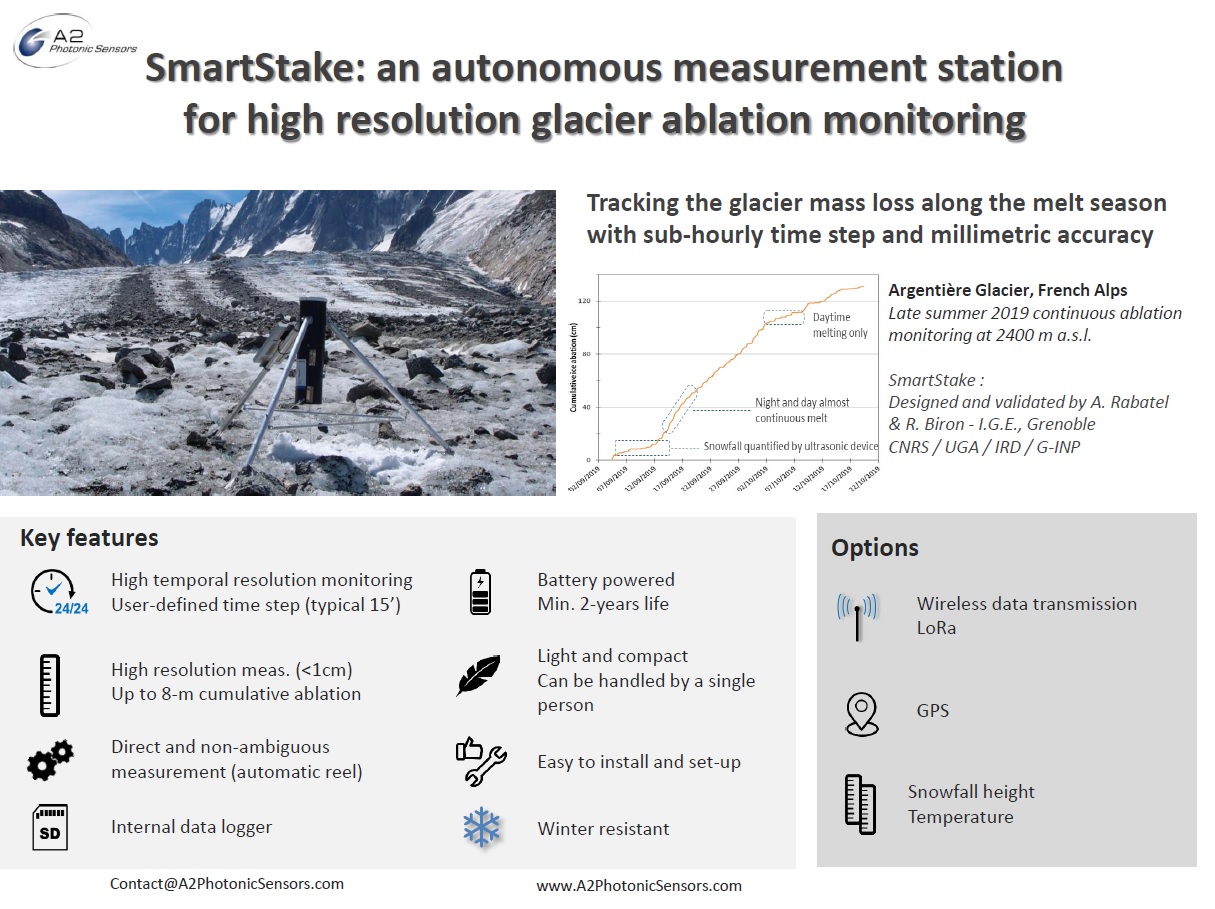In addition to worldwide data compilation and dissemination, the WGMS is continuously involved in capacity building and twinning activities. These activities are mostly covered by third party funded projects. The well-known glacier monitoring programmes and the WGMS network represent ideal platforms and gateways to reach local stakeholders. They are therefore considered essential channels for capacity building and twinning efforts. Reciprocally, these collaborations are very important enhancers of the monitoring programmes in terms of strengthening, maintaining, and improving systematic glacier and natural hazard monitoring.
Current capacity building and twinning projects and programmes at WGMS:
CICADA: “Cryospheric Climate Services for Improved Adapation”
 Climate change poses a major challenge for humanity and the related global implications will influence and threaten future economies and livelihood of coming generations, especially in developing countries. One region, where climate change has major impacts is Central Asia. With the Tien Shan and Pamir, the region contains two of the largest mountain systems of the world, which serve as water towers in arid and continental region. Future water resources in these regions depend strongly on the cryosphere, particularly on snow, glaciers and permafrost. These cryospheric components store enormous amounts of water in its solid form. These resources will play an important role for future water availability under the ongoing climate warming influencing future water resource management. Several recent studies (Hagg et al. 2007, 2013, Kaser et al. 2010, Huss and Hock 2018) point out clearly that a) in arid regions like Central Asia, water release by glaciers is fundamental to keep runoff sufficient during the dry summer months and b) at the end of this century the water contribution of glaciers will be drastically reduced and certain catchments will completely dry-out. This setting creates a complex set of future challenges in the areas of water management, energy production, irrigation, agriculture, environment, disaster risk reduction, security and public health. Notably this also poses challenges in the field of climate services, as the lack of reliable data and commitment of the governments to fully integrate their observatory systems inhibits the sustainable development of the region. Exactly at this point, the project CICADA (Cryospheric Climate Services for improved Adaptations), embedded in Switzerland’s Blue Peace Initiative for Central Asia, the University of Fribourg together with its partner organizations aims at improving cryospheric climate services and supporting the region in adapting to climate change. CICADA works on three different outcomes:
Climate change poses a major challenge for humanity and the related global implications will influence and threaten future economies and livelihood of coming generations, especially in developing countries. One region, where climate change has major impacts is Central Asia. With the Tien Shan and Pamir, the region contains two of the largest mountain systems of the world, which serve as water towers in arid and continental region. Future water resources in these regions depend strongly on the cryosphere, particularly on snow, glaciers and permafrost. These cryospheric components store enormous amounts of water in its solid form. These resources will play an important role for future water availability under the ongoing climate warming influencing future water resource management. Several recent studies (Hagg et al. 2007, 2013, Kaser et al. 2010, Huss and Hock 2018) point out clearly that a) in arid regions like Central Asia, water release by glaciers is fundamental to keep runoff sufficient during the dry summer months and b) at the end of this century the water contribution of glaciers will be drastically reduced and certain catchments will completely dry-out. This setting creates a complex set of future challenges in the areas of water management, energy production, irrigation, agriculture, environment, disaster risk reduction, security and public health. Notably this also poses challenges in the field of climate services, as the lack of reliable data and commitment of the governments to fully integrate their observatory systems inhibits the sustainable development of the region. Exactly at this point, the project CICADA (Cryospheric Climate Services for improved Adaptations), embedded in Switzerland’s Blue Peace Initiative for Central Asia, the University of Fribourg together with its partner organizations aims at improving cryospheric climate services and supporting the region in adapting to climate change. CICADA works on three different outcomes:
- On (re)-establishing a modern glacier monitoring system in Central Asia creating high-quality data feeding in openly accessible international databases (outcome 1)
- On increasing the (scientific) capacities, cooperation and awareness for cryosphere monitoring (outcome 2)
- On linking science to practice by establishing value chains of climate services from glacier data to water resource management and disaster risk reduction in pilot regions (outcome 3)
Current progress in the project was made by contributing to the improvement installing modern monitoring stations on glaciers (see also figure 1, Hoelzle et al. 2017), by training local students (Nussbaumer et al. 2017) and researchers and using this information in order to provide climate scenarios and services for water runoff and natural hazards (e.g. GLOFs, debris flows). This is a prerequisite to allow early planning and adaptation measures within the water resource management (WRM) and disaster risk reduction (DRR) sectors. These scenarios and services have to be based on calibrated models linked to high quality baseline data. The project is organized and partly financed by the University of Fribourg under the auspice of the World Glacier Monitoring Service (WGMS) with a contribution of the Swiss Agency for Development and Cooperation (SDC).  References: Hagg, W., Braun, L., Kuhn, M., and Nesgaard, T. I., 2007, Modelling of hydrological response to climate change in glacierized Central Asian catchments: Journal of Hydrology, v. 332, p. 40-53. Hagg, W., Hoelzle, M., Wagner, S., Mayr, E., and Klose, Z., 2013, Glacier and runoff changes in the Rukhk catchment, upper Amu-Darya basin until 2050: Global and Planetary Change, v. 110, p. 62-73. Hoelzle M, Azisov E, Barandun M, Huss M, Farinotti D, Gafurov A, Hagg W, Kenzhebaev R, Kronenberg M, Machguth H, Merkushkin A, Moldobekov B, Petrov M, Saks T, Salzmann N, Schöne T, Tarasov Y, Usubaliev R, Vorogushyn S, Yakovlev A, Zemp M (2017) Re-establishing glacier monitoring in Kyrgyzstan and Uzbekistan, Central Asia. Geoscientific Instrumentation Method and Data Systems 6:397-418 Huss M, Hock R., 2018, Global-scale hydrological response to future glacier mass loss. Nature Climate Change. Kaser, G., Grosshauser, M., and Marzeion, B., 2010: Contribution potential of glaciers to water availability in different climate regimes: PNAS, v. 107, no. 47, p. 20223-20227. Nussbaumer SU, Hoelzle M, Hüsler F, Huggel C, Salzmann N, Zemp M (2017) Glacier Monitoring and Capacity Building: Important Ingredients for Sustainable Mountain Development. Mountain Research and Development 37(1):141-152
References: Hagg, W., Braun, L., Kuhn, M., and Nesgaard, T. I., 2007, Modelling of hydrological response to climate change in glacierized Central Asian catchments: Journal of Hydrology, v. 332, p. 40-53. Hagg, W., Hoelzle, M., Wagner, S., Mayr, E., and Klose, Z., 2013, Glacier and runoff changes in the Rukhk catchment, upper Amu-Darya basin until 2050: Global and Planetary Change, v. 110, p. 62-73. Hoelzle M, Azisov E, Barandun M, Huss M, Farinotti D, Gafurov A, Hagg W, Kenzhebaev R, Kronenberg M, Machguth H, Merkushkin A, Moldobekov B, Petrov M, Saks T, Salzmann N, Schöne T, Tarasov Y, Usubaliev R, Vorogushyn S, Yakovlev A, Zemp M (2017) Re-establishing glacier monitoring in Kyrgyzstan and Uzbekistan, Central Asia. Geoscientific Instrumentation Method and Data Systems 6:397-418 Huss M, Hock R., 2018, Global-scale hydrological response to future glacier mass loss. Nature Climate Change. Kaser, G., Grosshauser, M., and Marzeion, B., 2010: Contribution potential of glaciers to water availability in different climate regimes: PNAS, v. 107, no. 47, p. 20223-20227. Nussbaumer SU, Hoelzle M, Hüsler F, Huggel C, Salzmann N, Zemp M (2017) Glacier Monitoring and Capacity Building: Important Ingredients for Sustainable Mountain Development. Mountain Research and Development 37(1):141-152
CATCOS: “Capacity Building and Twinning for Climate Observing Systems”
In the context of the Global Climate Observing System (GCOS), the project CATCOS aims at improving the capacity for measurements of greenhouse gases, aerosols and glacier mass balances in different regions of the world with data gaps. In close collaboration with regional partners, the glaciological work packages of the project aim at (i) continuing in-situ mass balance measurements at La Conejera (CO) and Antizana15Alpha (EC) in combination with (ii) new geodetic surveys of these glaciers, as well as (iii) re-initiating in-situ mass balance measurements at Abramov, Golubin, and Suyok Zapadniy glaciers (KG). The project is coordinated by MeteoSwiss and funded by the Swiss Agency for Development and Cooperation. Blog entry by MeteoSwiss on the “Completion of the CATCOS project” (26.04.2017, in german only) 
SMD4GC: “Sustainable Mountain Development for Global Change”
Within the SMD4GC programme, support to sustainable mountain development (SMD) is provided to increase the resilience of the mountain population, which is most vulnerable to the ongoing global changes. The overall goal of SMD4GC is to essentially contribute to SMD under uncertain changes in climatic, environmental and socio-economic conditions, focusing on poverty and risk reduction. Thereby, the main focus is on knowledge management and targeted capacity building and twinning activities related to internationally coordinated glacier monitoring. These include the compilation of a global cooperation database to increase the visibility of Principal Investigators involved in glacier monitoring, the country-wise assessment of the glacier monitoring status, the organization of training courses (see below), the hosting of guest scientists at University of Zurich and WGMS (see below), and on-site support. Moreover, SMD issues will be integrated in existing capacity building courses, especially on postgraduate university levels. The programme is funded by the Swiss Agency for Development and Cooperation. More details on the programme and the URL’s of related partners are given in Wehrli (2014): Why Mountains Matter for Sustainable Development. Mountain Research and Development 34(4): 405-409. 2014 doi: http://dx.doi.org/10.1659/MRD-JOURNAL-D-14-00096.1
TRAINING COURSES
The WGMS regularly organizes international summerschools on mass balance measurements and analysis. The participants, mainly local investigators involved in ongoing mass balance programmes in their region, are trained in both field and office work by an international team of experts in glacier monitoring and capacity building. The summer schools in Zermatt (CH, 2013), Bishkek (KG, 2015), and La Paz (BO, 2016) are carried out within the framework of the project CATCOS while upcoming summer schools are planned to be realized within the SMD4GC programme.
- training course 2013 in Switzerland
- training course 2015 in Kyrgyzstan
- training course 2016 in Bolivia
2-8 August 2015, Central Asian Institute for Applied Geosciences, Bishkek and Suyok Zpapadniy Glacier, Kyrgyzstan (Photograph by Horst Machguth)
GUEST SCIENTISTS & TRAINEES
As part of its capacity building and twinning activities, the WGMS regularly hosts and welcomes researchers from all over the world to work as a guest scientist at the University of Zurich. This exchange of experience forms the basis for successful collaborative projects and/or publications and helps to disseminate knowledge on glacier monitoring. Furthermore, the WGMS continuously offers internships to young international trainees to assist the team in their daily business.
PARTNERSHIP WGMS-GLACIOCLIM
In 2015, the WGMS and the GLACIOCLIM, run by LGGE and LTHE (OSUG) in France, signed a Memorandum of Understanding (MoU) with the purpose to establish a working relationship of mutual collaboration between the two institutions. The aim of this effort is not only to gather long-term glaciological data but also to coordinate and strengthen capacity building and twinning activities in order to enhance the monitoring and scientific study of the world’s glaciers. Both sides agree to contribute in a joint effort to train students and local partners in their regions of interest where glacier monitoring is performed. On the long term, this is expected to highly improve the availability, quality, and accuracy of glacier data.
PARTNERSHIP WGMS-KILIAN JORNET FOUNDATION
In 2020, the WGMS signed a Memorandum of Understanding (MoU) with the Kilian Jornet Foundation. The main purpose is to establish a working relationship of mutual collaboration to contribute to monitoring of glaciers and to take different actions to show the importance that glaciers have in our ecosystem. Funds collected will go to different initiatives promoted by the WGMS, from measuring devices and equipment for researchers to education programs for schools, among others.
The first project focuses on autonomous measurement stations for monitoring high-resolution glacier ablation processes that will be used by the WGMS network. These stations, known as SmartStakes and developed in France, make it possible to measure the ablation and monitor it online at high temporal scale, in order to better understand the effects of global warming on glaciers.



